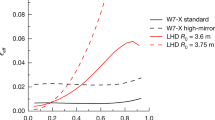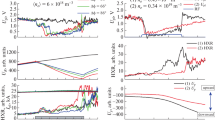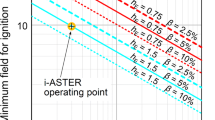Abstract
Transient coaxial helicity injection (CHI) is a promising candidate for solenoid-free plasma current start-up in a low-aspect-ratio tokamak in support of developing fully non-inductive scenarios. The aim of the transient CHI research on QUEST is to develop a reactor-relevant CHI design. On QUEST, a CHI discharge is initiated by driving current along magnetic field lines that connect an electrically insulated electrode plate (which is referred to as a bias electrode) to a vessel component at the bottom region of the spherical tokamak. In the first application of CHI on QUEST, the electrically insulated electrode plate was biased with respect to the outer vessel in a configuration referred to as low-field-side (LFS) injection. To maintain a narrow injector flux footprint width throughout the discharge, QUEST is now developing a high-field-side (HFS) injection configuration, in which the electrically insulated electrode plate is biased with respect to the inner vessel components. Through the implementation of a CHI-dedicated gas injection system, studies in the HFS injection configuration have now demonstrated good magnetic flux evolution into the vacuum vessel. Toroidal currents up to 43 kA have been achieved, and the generated current has increased in proportion to the magnetic flux connecting the electrodes. These results which show agreement with the CHI-scaling suggest that much higher levels of toroidal current can be generated on QUEST in an optimized CHI system in which the magnetic flux connecting the CHI electrodes is further increased.






Similar content being viewed by others
References
Y.-K.M. Peng, Phys. Plasmas 7, 1681 (2000)
J.E. Menard et al., Nucl. Fusion 56, 106023 (2016)
S.M. Kaye et al,, Nucl. Fusion 55, 104002 (2015)
R. Raman et al,, Phys. Rev. Lett. 97, 175002 (2006)
M. Gryaznevich et al,, Phys. Plasmas 10, 1803 (2003)
B. Lloyd et al,, Nucl. Fusion 51, 094013 (2011)
K. Hanada et al,, Plasma Sci. Technol. 13, 307 (2011)
M. Ishiguro et al,, Phys. Plasmas 19, 062508 (2012)
R. Raman, T.R. Jarboe, B.A. Nelson, V.A. Izzo, R.G. O’Neill, A.J. Redd, and Smith R. J, Phys. Rev. Lett. 90, 075005 (2003)
D.J. Battaglia, M.W. Bongard, R.J. Fonck, A.J. Redd, A.C. Sontag, Phys. Rev. Lett. 102, 225003 (2009)
M. Uchida, T. Yoshinaga, H. Tanaka, T. Maekawa, Phys. Rev. Lett. 104, 065001 (2010)
K.J. Chung, Y.H. An, B.K. Jung, et al,, Plasma Sci. Technol. 15, 244 (2013)
W. Choe, J. Kim, M. Ono, Nucl. Fusion 45, 1463 (2005)
T.R. Jarboe, Fusion Sci. Technol. 15, 7 (1989)
T.R. Jarboe, Plasma Phys. Controlled Fusion 36, 945 (1994)
J.B. Taylor, Rev. of Modern Physics 58 No, 3 741 (1986)
R. Raman, T.R. Jarboe, B.A. Nelson, W.T. Hamp, V.A. Izzo, R.G. O’Neill, A.J. Redd, P.E. Sieck, R.J. Smith, Phys. Pasmas 11, 2565 (2004)
R. Raman et al,, Phys. Plasmas 18, 092504 (2011)
B.A. Nelson et al,, Nucl. Fusion 51, 063008 (2011)
K. Kuroda et al,, Plasma. Fusion. Res. 12, 1202020 (2017)
K. Kuroda et al,, Plasma Phys. Controlled Fusion 60, 115001 (2018)
K. Hanada et al,, Plasma. Fusion. Res. 5, S1007 (2010)
K. Hanada et al,, Nucl. Fusion 57, 126061 (2017)
K. Hanada et al,, Plasma Sci. Technol. 18, 1069 (2016)
M. Hasegawa et al,, Plasma Fusion Res 16, 2402034 (2021)
K. Hanada et al, 2020 Proc. on 28th IAEA Fusion Energy Conference (FEC 2020) EX/P7-14
H. Idei et al,, Nucl. Fusion 57, 126045 (2017)
H. Idei et al,, Fusion Eng. Des. 146, 1149 (2019)
T. Onchi et al,, Phys. Plasmas 28, 022505 (2021)
T. Onchi et al, 2020 Proc. on 28th IAEA Fusion Energy Conference (FEC 2020) EX/P7-15
R. Raman, T. Brown, L.A. El-Guebaly, T.R. Jarboe, B.A. Nelson, J.E. Menard, Fusion Sci. Technol. 68, 674 (2015)
K.C. Hammond, R. Raman, F.A. Volpe, Nucl. Fusion 58, 016013 (2018)
R. Raman et al,, Nucl. Fusion 53, 073017 (2013)
K. Kuroda et al,, Plasma. Fusion. Res. 16, 2402048 (2021)
F. Ebrahimi, R. Raman, Phys. Rev. Lett. 114, 205003 (2015)
D. Mueller et al., IEEE Trans. Plasma Sci. 38, 371 (2010)
Acknowledgements
This work is supported by US DOE grants (DE-SC0019415, and DE-AC02-09CH11466), NIFS Collaboration Research Program (NIFS17KUTR130 and NIFS19KUTR137), the Collaborative Research Program of Research Institute for Applied Mechanics, Kyushu University (International Collaboration Frame-work 18 NU-1 and 19 NU-1 and early career scientists support work), and a Grant-in-Aid for JSPS Fellows (KAKENHI Grant No. 19K14685). This work was partially supported by a Grant-in-Aid for JSPS Fellows (KAKENHI Grant No. 17H06089), the NIFS Collaboration Research Program (NIFS19KUTR136 and NIFS13KUTR085), and Japan/US Cooperation in Fusion Research and Development.
Author information
Authors and Affiliations
Corresponding author
Additional information
Publisher’s Note
Springer Nature remains neutral with regard to jurisdictional claims in published maps and institutional affiliations.
Rights and permissions
Springer Nature or its licensor (e.g. a society or other partner) holds exclusive rights to this article under a publishing agreement with the author(s) or other rightsholder(s); author self-archiving of the accepted manuscript version of this article is solely governed by the terms of such publishing agreement and applicable law.
About this article
Cite this article
Kuroda, K., Raman, R., Hasegawa, M. et al. Improvements to the High-Field-Side Transient CHI System on QUEST. J Fusion Energ 41, 25 (2022). https://doi.org/10.1007/s10894-022-00338-4
Received:
Revised:
Accepted:
Published:
DOI: https://doi.org/10.1007/s10894-022-00338-4




